Cold Curry Udon is a summertime dish of thick Japanese wheat noodles soaked in chilled curry soup and topped with sliced pork and fresh vegetables. It‘s a colorful, nutritious, and refreshingly savory meal on a warm day.
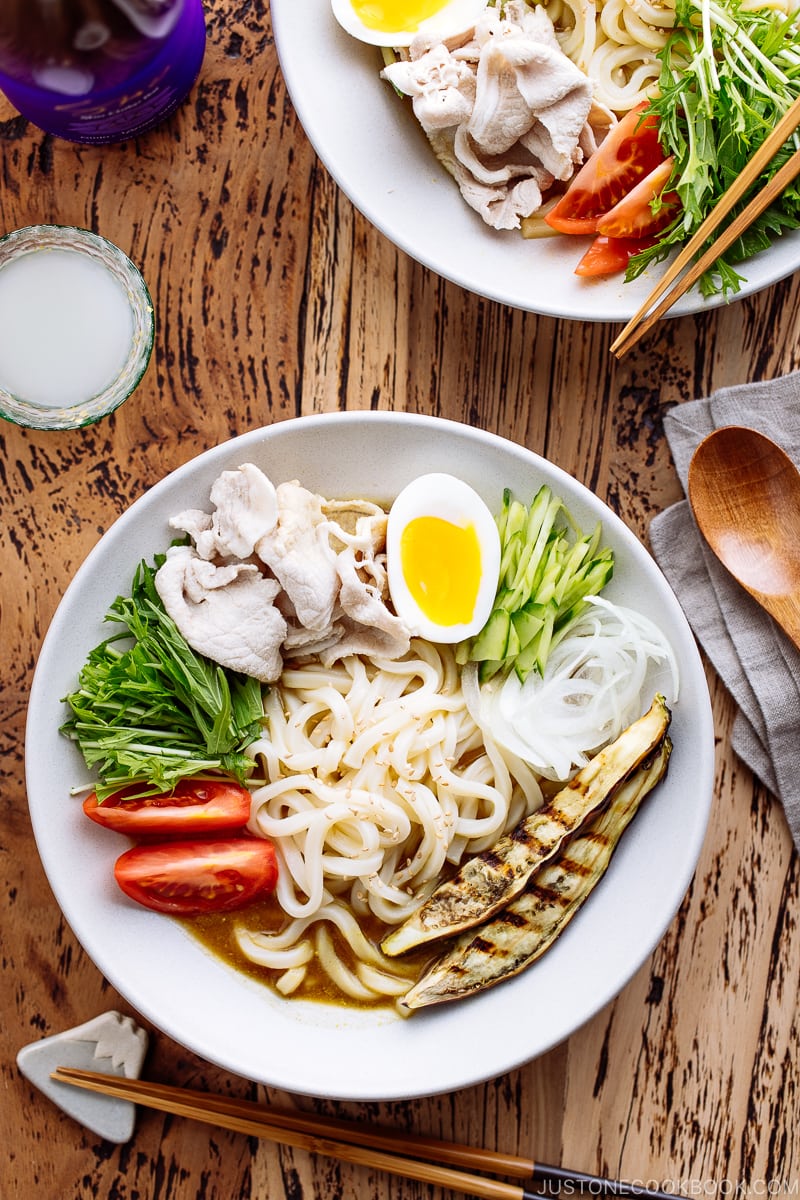
If sandwiches are a common lunch menu in the United States, noodle dishes are the equivalent counterpart in Japan. We eat noodles all year round because nothing will keep Japanese people from their noodles.
During the summer months, noodle shops offer extensive cold soba or cold udon noodle menus that refresh the palate and keep things cool. Home cooks in Japan make varieties of cold noodle dishes, and today’s recipe – Cold Curry Udon (冷やしカレーうどん) – is enjoyable to dig into during these sweltering days.
The refreshing contrast of textures and flavors is one of the key advantages of this recipe. It also features the freshest, crispest summer vegetables available at the market: tomatoes, cucumbers, fresh greens, and eggplant. Change up the ingredients and you can easily live off a variation of this cold curry udon all season long.
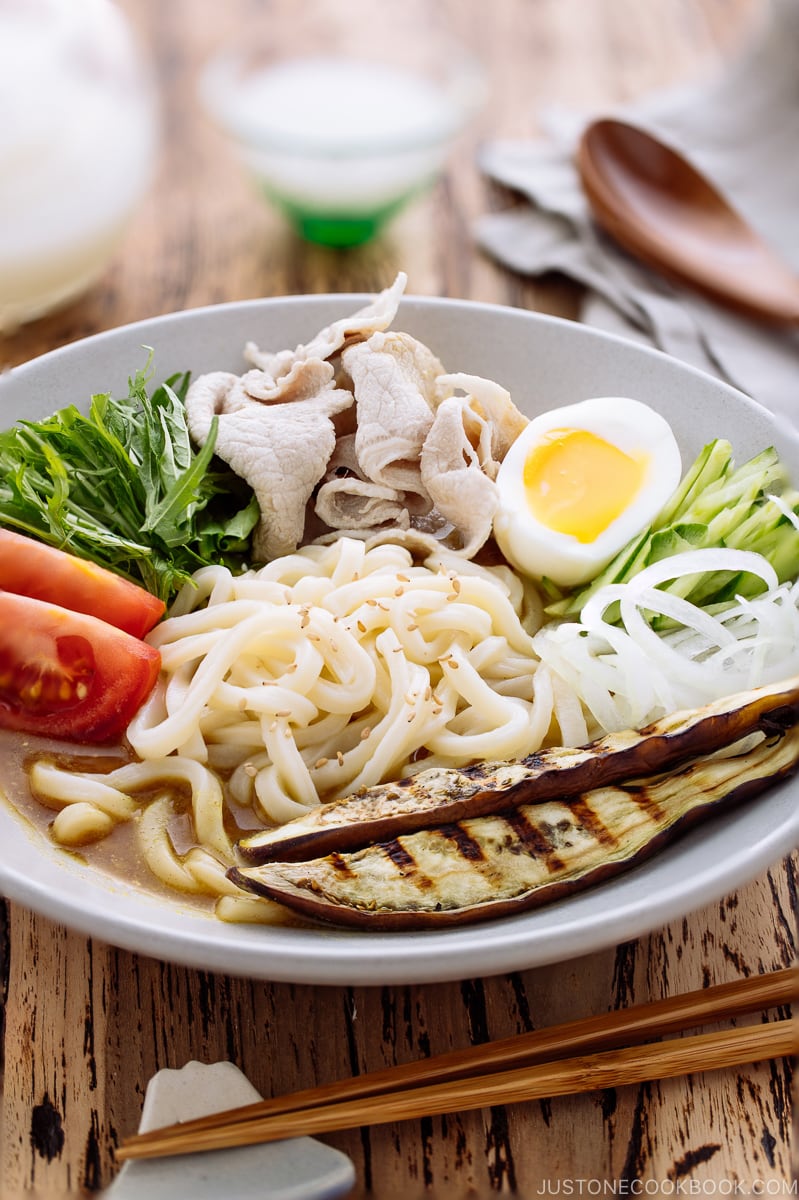
3 Reasons Why You’ll Love This Cold Curry Udon
1. Easy
For a well-balanced bowl of noodles, it is fairly straightforward and quick to assemble. You can prepare all of the components ahead of time and keep in the refrigerator until you’re ready to eat, which makes it an ideal weeknight meal. If you enjoy Japanese Curry, you will love this dish!
2. Versatile
The mild flavor of silky udon noodles and bold curry, when paired together, are surprisingly accommodating. They can take on an array of ingredients and taste delicious every time. Have some leftover grilled meat or vegetables from the weekend barbecue? Toss them into the noodles. Take a quick scan around your refrigerator and you’ll find some fresh produce ready to be used. Because you don’t cook the ingredients with the curry roux, you can add uncooked vegetables as toppings for this cold curry, which is another reason why it can be made really fast.
3. Delicious (plus Nutritious)
Sometimes delicious food may not be nutritious, but this Cold Curry Udon is filled with veggies and protein – which makes it wholesome and satisfying. It’s easy to lose appetite on hot summer weather, but curry helps revive the appetite, and serving it chill adds a more appetizing effect.
How About Hot Curry Udon?
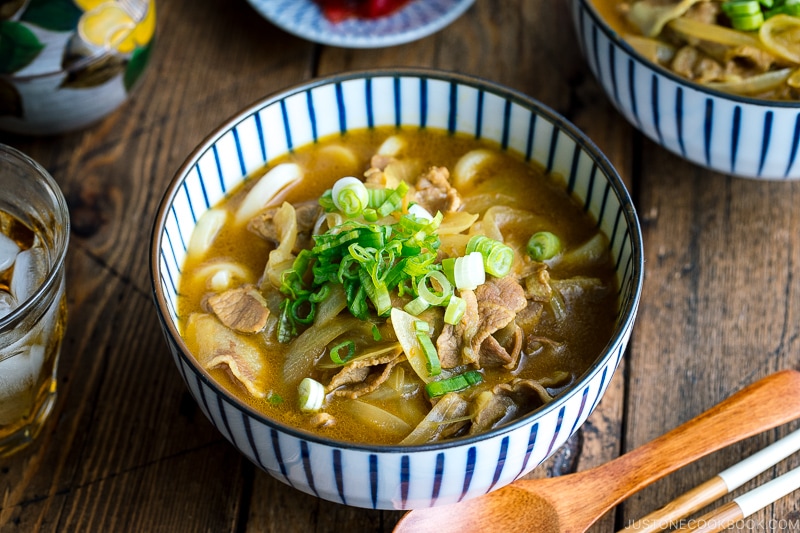
But if you don’t mind sweating over a hot noodle soup on a hot day, I have a regular Curry Udon recipe that you can enjoy as well.
Ingredients You Need
Let’s look into the ingredients that make this cold udon bowl.
- Dashi: For the authentic Japanese flavor, I strongly recommend using dashi as the curry soup’s broth. You can either make dashi from scratch or use the convenient dashi packet method or dashi powder (See 3 ways to make dashi). If you really have to skip it, then use chicken stock instead. I haven’t tried it with chicken broth, but it should be okay.
- Thinly Sliced Pork: Japanese, Korean, and Chinese grocery stores sell thinly sliced meat in packages. No access to these grocery stores? You can prepare your own thinly sliced pork by following my step-by-step guide or video tutorial. If you don’t eat pork, chicken or prawn would work too.
- Japanese Curry Roux: If you are interested in avoiding MSG and making your own curry roux, please follow my homemade curry roux recipe.
- Sake & Mirin: Read more about these condiments in the next section. For substitute info, please click here.
- Toppings/Ingredients: It is a highly adaptable dish, so feel free to work with a colorful variety of vegetables and protein of your choice. You can pretty much prepare everything ahead of time as the toppings are best to be chilled. When you’re ready to serve, you just need to assemble the bowl together. Perfect for a make-ahead meal.
- Udon Noodles: Udon noodles in your local Japanese or Asian grocery stores are probably frozen, refrigerated, or dried. Among all the varieties we have outside Japan, I think the frozen udon noodles are the best in terms of texture and flavor. If you can’t find the frozen variety, use dried udon noodles instead of refrigerated udon noodles. I’m not sure why but udon noodles you can find in the refrigerator are easily broken into pieces (this doesn’t happen for the ones in Japan), and I never found a good quality one…
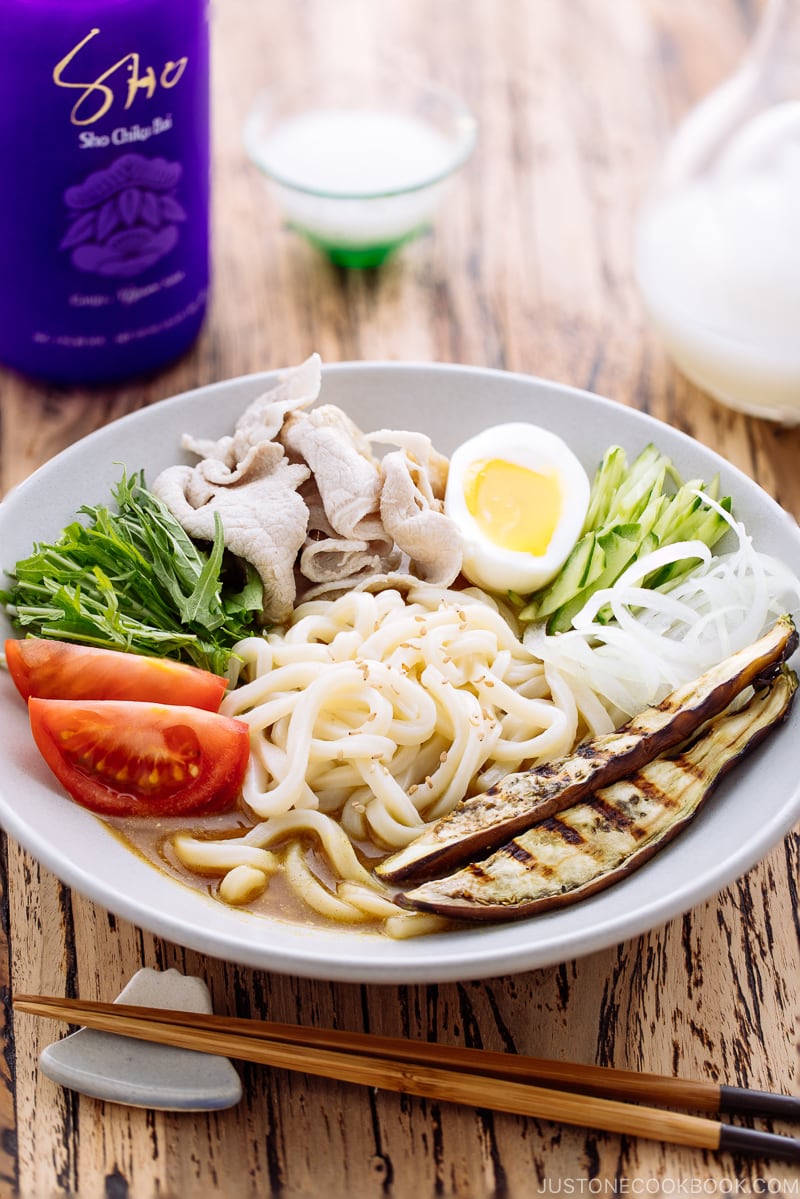
Cooking with Sake & Mirin
To make the curry sauce for this recipe, you’ll only need 4 simple ingredients: Japanese curry roux, sake, mirin, and soy sauce.
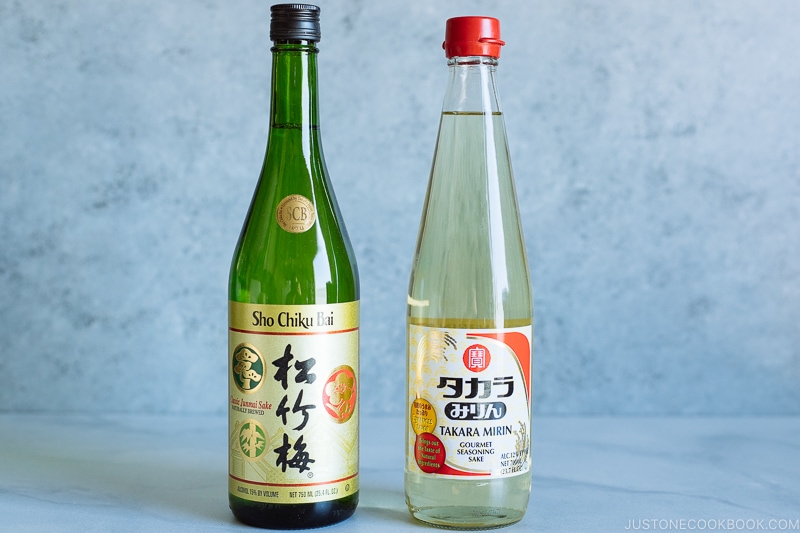
Sake (fermented alcohol made from rice and water) and mirin (sweetened rice wine) are all part of the building blocks in maximizing the flavor of this Cold Curry Udon. The benefits of cooking with sake and mirin are aplenty, and in this instance, sake lends acidity and helps intensify the overall flavor while mirin adds a subtle sweetness to the curry sauce.
To learn more about the differences between sake and mirin, and the benefits of cooking with them, you can read this post on the blog.
The sake and mirin I used for this Cold Curry Udon are from Takara Sake, which has more than one-and-a-half centuries of experience in Japanese alcohol production. In the US, they are based out of Berkeley, California but you can also find them online or at some local sake or liquor stores.
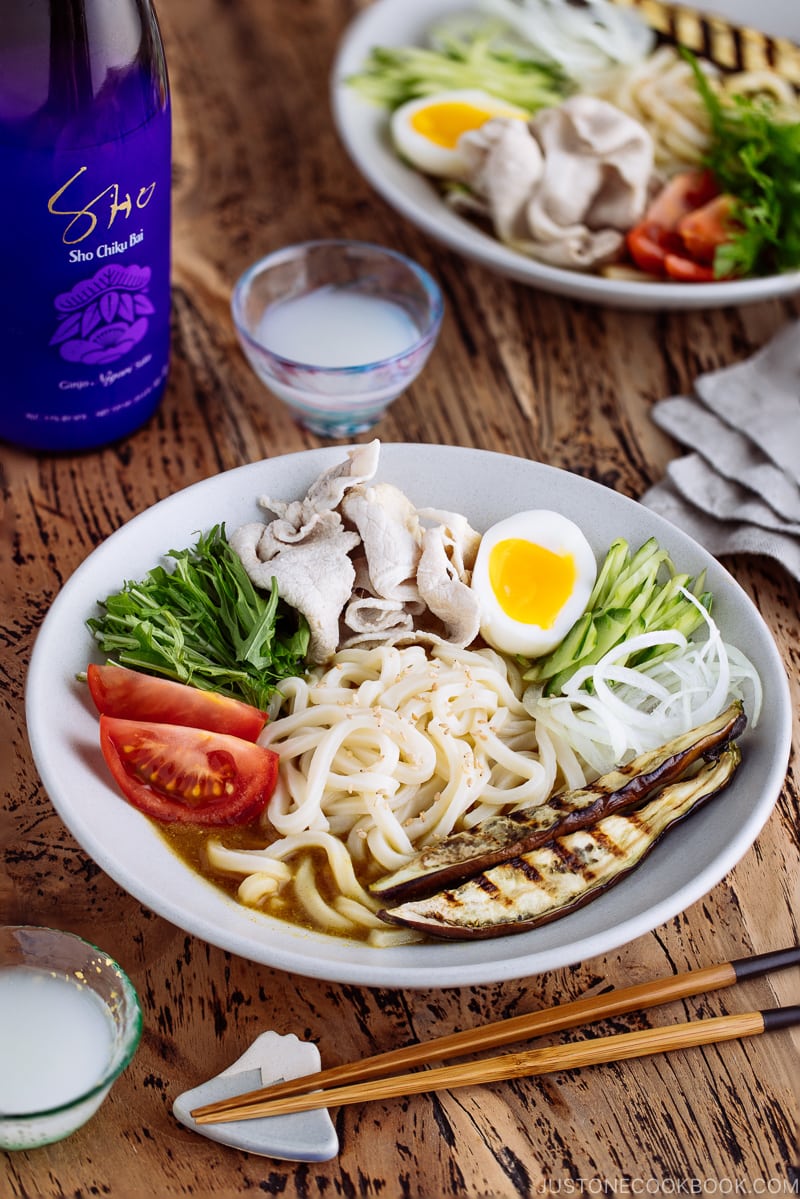
Sake Pairing with Cold Curry Udon
While cold beer is always welcome, sake tends to work very well with light cold noodles. With this Cold Curry Udon, we’d pair it with Sho Chiku Bai SHO Ginjo Nigori Sake by Takara Sake. In case you are not familiar with different types of sake, nigori sake is cloudy as it’s less filtered than regular sake, and still contain rice particles.
Nigori sake is typically sweeter and works well with spicy and flavorful food like barbecue, Mexican food, and curries. For this cold udon curry, Sho Chiku Bai SHO Ginjo Nigori Sake worked perfectly as it is very fruity and just the right amount of sweet, with a slightly grainy texture. The sweetness cleans the palette and makes every bite of curry even intense and flavorful.
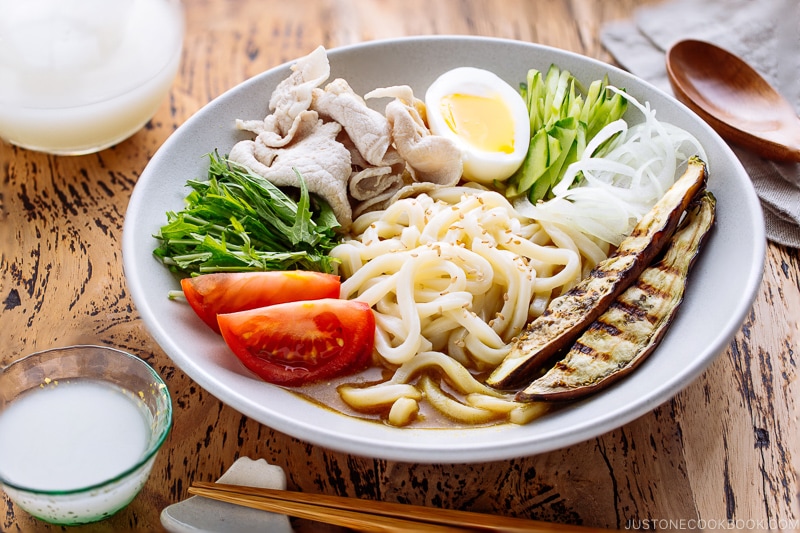
Wish to learn more about Japanese cooking? Sign up for our free newsletter to receive cooking tips & recipe updates! And stay in touch with me on Facebook, Pinterest, YouTube, and Instagram.
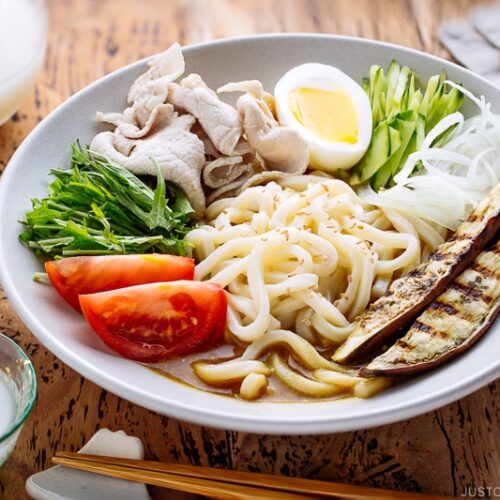
Cold Curry Udon
Ingredients
- 2 cups dashi (Japanese soup stock) (use standard Awase Dashi, dashi packet or powder, or Vegan Dashi)
- 4 oz thinly sliced pork (6 pieces; skip for vegan/vegetarian)
- 2 servings udon noodles (1.1 lb/500 g frozen or parboiled udon noodles; 6.3 oz/180 g dry udon noodles)
For the Toppings
- 1 Japanese eggplant
- 1 Tbsp neutral oil (for cooking the eggplant)
- ½ onion (3 oz, 75 g)
- 1 Japanese or Persian cucumber
- 1 tomato
- 1 bunch mizuna (Japanese mustard green) (or any leafy salad)
- 1 hard-boiled egg (cut in half lengthwise; skip for vegan)
- 1 tsp toasted white sesame seeds
For the Seasoning
- 1 cube Japanese curry roux (1 oz, 32 g)
- 1 Tbsp sake (I used Takara Sake® Sho Chiku Bai)
- 3 Tbsp mirin (I used Takara® Mirin)
- 2 Tbsp soy sauce
Instructions
- Gather all the ingredients.

- In a small pot, add 2 cups dashi (Japanese soup stock) and bring it to boil over medium heat.

- Cook 4 oz thinly sliced pork one at a time in the dashi. Try not to overcook as it gets tough. Once the pork is no longer pink, quickly remove it from the dashi.

- Place the cooked pork in iced water. Once cooled, transfer to a plate.

To Prepare the Curry Soup
- Skim off the fat and foam from the surface of the dashi.

- Add 1 cube Japanese curry roux to a ladleful of hot dashi and let it dissolved completely in the ladle before releasing it to the broth. If you drop the curry roux cube in the dashi, it’s much harder to dissolve.

- Add 1 Tbsp sake and 3 Tbsp mirin.

- Add 2 Tbsp soy sauce and mix together. Bring the soup to a simmer.

- Skim off the foam and cook for 1 minute. Cool the pot with the curry soup in an ice bath. Once it’s cool, you can move to the refrigerator.

To Prepare the Vegetables
- Cut 1 Japanese eggplant into 4 wedges lengthwise. Heat 1 Tbsp neutral oil in a pan. I use a cast iron grill pan to achieve grill marks.

- Cook all sides of the eggplant until tender.

- Slice ½ onion thinly. I use a mandoline slicer to get thin onion slices. Soak in iced water to remove the bitterness.

- Peel the skin of 1 Japanese or Persian cucumber, alternating peeled and unpeeled skin. Slice the cucumber and cut into julienne strips.

- Cut 1 tomato into wedges. Cut 1 bunch mizuna (Japanese mustard green) into small pieces.

To Make the Cold Curry Udon
- Pour the chilled curry soup into individual serving bowls. You can remove the fat on the surface of the curry soup with a fine-mesh skimmer or strain the curry soup through a fine-mesh sieve.

- Bring a large pot of water to a boil for the udon noodles. My favorite udon is frozen Sanuki Udon. Cook 2 servings udon noodles (frozen) in boiling water for 1 minute (no need to defrost). If you use dry noodles, follow the package instructions. Drain and run under cold water to chill the udon.

- Divide the udon and place in the curry soup. Add the toppings: the pork, halves of 1 hard-boiled egg, grilled eggplant, sliced onion, julienned cucumber, tomato wedges, and mizuna. Sprinkle with 1 tsp toasted white sesame seeds and enjoy.

To Store
- You can keep the soup and toppings in airtight containers separately, but I recommend preparing the udon noodles right before you serve. Store in the refrigerator for 3 days and in the freezer for a month.
Nutrition
Visit Takara Sake Tasting Room in Berkeley
If you live in the SF Bay Area or plan on visiting San Francisco, we recommend stopping by the beautiful Takara Sake tasting room in Berkeley.

They have an amazing selection of sake and you get to sample different flights of the Japanese rice wine. Whether you are a sake connoisseur or just a novice, it is definitely a fun place to go.

And don’t forget to grab a bottle of Sho Chiku Bai SHO Junmai Ginjo to enjoy with this Cold Udon Curry!

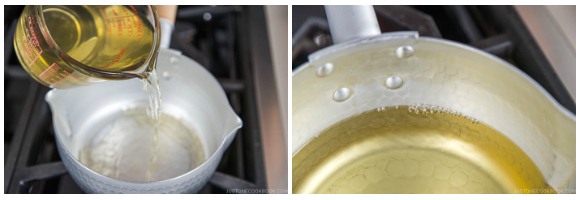
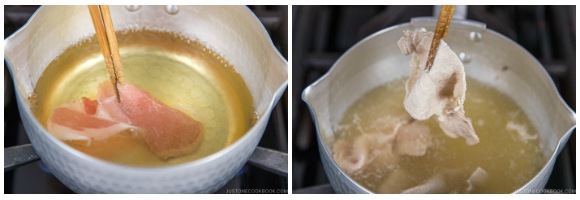
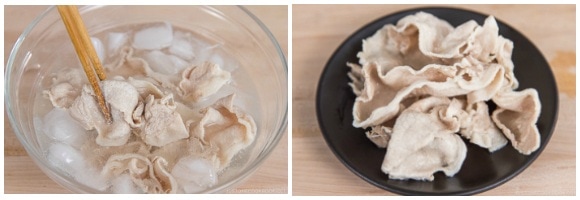
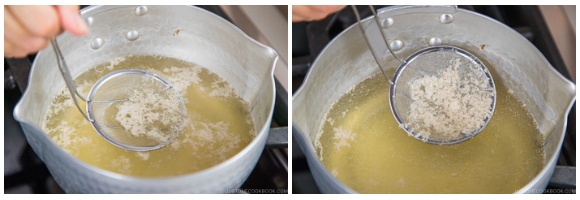
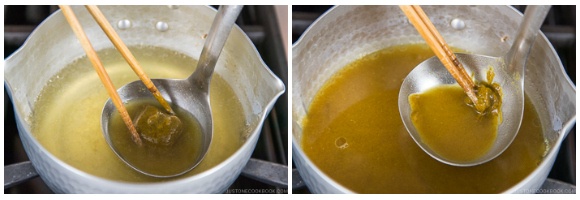
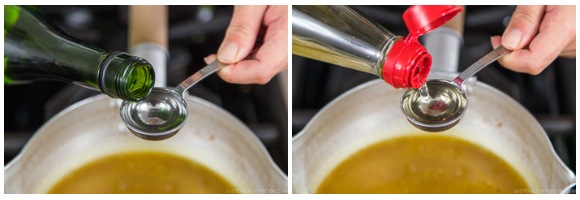

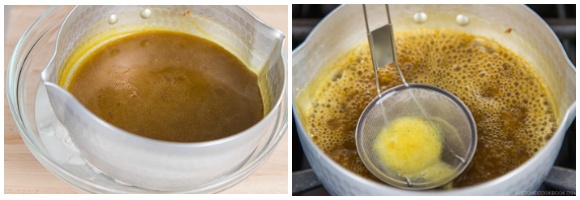
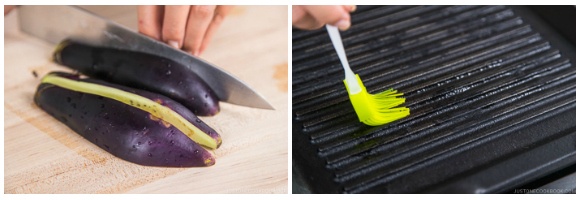
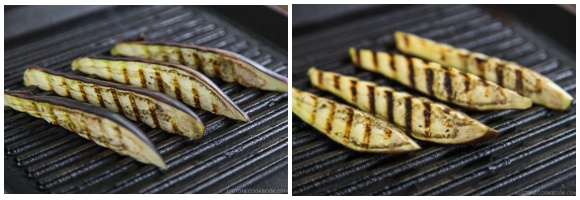
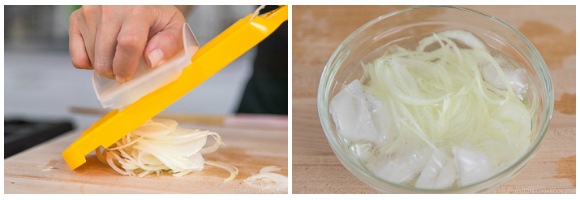
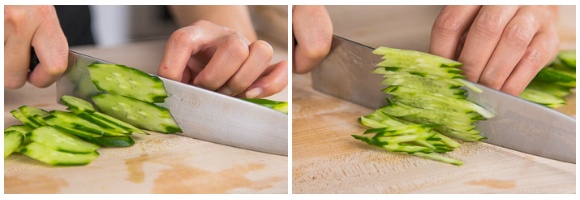
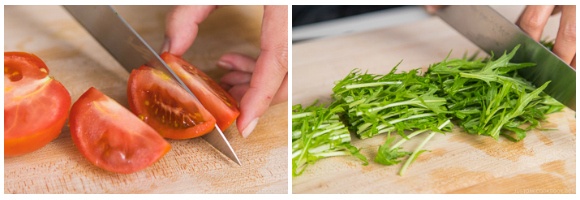
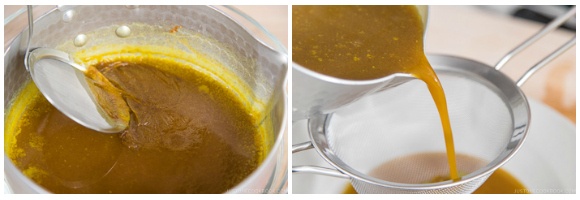

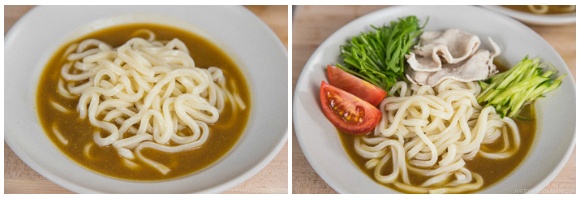










Hello! Do you think I could use japanese curry powder instead of the cube to make it? that’s what I got on hand right now. Thank you!
Hello Mathilde! Thank you for giving Nami’s recipe a try.
However, using Japanese curry powder alone may not provide the full flavor and could result in a bland and less thick soup. Why not try making curry roux cubes using Nami’s recipe instead? You can find the recipe at https://www.justonecookbook.com/how-to-make-curry-roux/.
We hope you find this suggestion helpful!🙂
I made this cold curry udon recipe. We Loved it! Made my own dashi (your recipe). Used egg rather than meat (vegetarian) and Kale rather than mizuna. It’ll be in our regular rotation for cold summer salads. Thank you.
Hi Clayton! Thank you so much for trying Nami’s recipe and for your kind feedback!
We are so happy to hear that you enjoyed Cold Curry Udon! Thank you for sharing your cooking experience with us!
I made this curry with the Just One Cookbook roux recipe and fresh tomato and cucumber from the garden. I didn’t expect the fresh produce would taste so nice in curry since everything is cooked in Indian curry, but it really was nice. I also modified the recipe by excluding the animal protein (I only used eggs) because I am a vegetarian, and it still tastes good. Thank you for sharing this idea. 👍
Hi Kirsti! Thank you so much for trying this recipe with my homemade roux recipe! It must be so nice to use vegetables from your garden! Thank you for your kind feedback. 🙂
[…] Cold Curry Udon […]
[…] Cold Curry Udon […]
Can I check how many curry roux blocks to use? It’s not in the ingredients. Is it one cube (out of four) or do you use all of them (like making a curry)?
Hi Corin! One cube (block) – and it’s located on top left in the ingredient picture (see the brown square roux?). 🙂 It’s 1 oz. or 32 g.